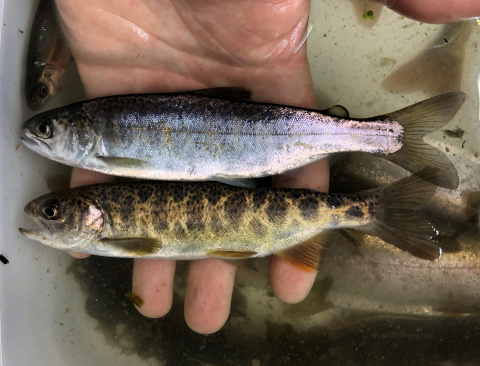The old cliche that you can't judge a book by its cover also applies to Chinook salmon. We think we know about them in general terms – they are born in Idaho's rivers, migrate to the ocean and then return as large adults to spawn. But there's more to the story with Idaho's Chinook salmon, and interestingly, males can behave significantly different than females.
Chinook salmon have complicated and highly variable life histories driven by environmental factors, growth and genetics. Baby chinook, known as fry, typically emerge from the gravel in the winter, spend the summer growing in their natal streams as parr (more about parr here) and begin the downstream migration to the ocean in the fall as pre-smolts.
Normally, these fish spend several years foraging in the Pacific Ocean before returning as adults to their natal freshwater streams to spawn. However, sometimes Chinook salmon don't follow that template and have alternative life history strategies. Chinook salmon that reach a relatively large size at a young age may decide to spawn sooner.

Out-migrating smolt (top) and a precocial male (bottom). Note the silvery appearance of the smolt compared to the parr marks of the precocial.
For example, some Chinook become sexually mature after just a few months in the estuary or after one year in the ocean. These salmon are called minijacks and jacks, respectively.
Additionally, some male parr, while still in freshwater, may become sexually mature in as little as 5 months after emerging from the gravel. While larger than the average parr, they may still only be 3 to 6 inches in length. These mature parr, also known as precocial males, may either develop into a resident fish that lives out its life in the headwater rivers, or they may attempt to migrate to the ocean the following year.

A female Chinook salmon on a redd (depression where eggs are deposited). Notice the four sneaker males around the redd.
These precocial young males can spawn with adult females and are referred to as sneaker males. Despite the fact that they can be less than a tenth of the size of an ocean-returning adult Chinook, sneaker males are able to successfully mate with females by employing a tactic known as swarming.
While the dominant male is distracted chasing off other competitors, tiny sneaker males are able to tend to the spawning female, remaining largely unnoticed. Although their tactics may seem devious, having sneaker males present can be beneficial to salmon populations.

While adult salmon are busy with dominance displays, precocial males go largely unnoticed.
This diversity in life history strategies has set Chinook salmon up for success. In a variable environment, genetic, phenotypical and behavioral variation increases the species’ chances of survival. It’s an evolutionary way to avoid “putting all of your eggs in one basket”. If one population of fish experiences unfavorable conditions, spawning activity can be bolstered by the other life history forms present in the system.
For example, if only a single female salmon makes it back to her spawning grounds, she may spawn successfully if sneaker males are around. Although anglers rarely interact with this form of Chinook salmon, they are an important and fascinating component of Idaho’s Chinook salmon populations.

